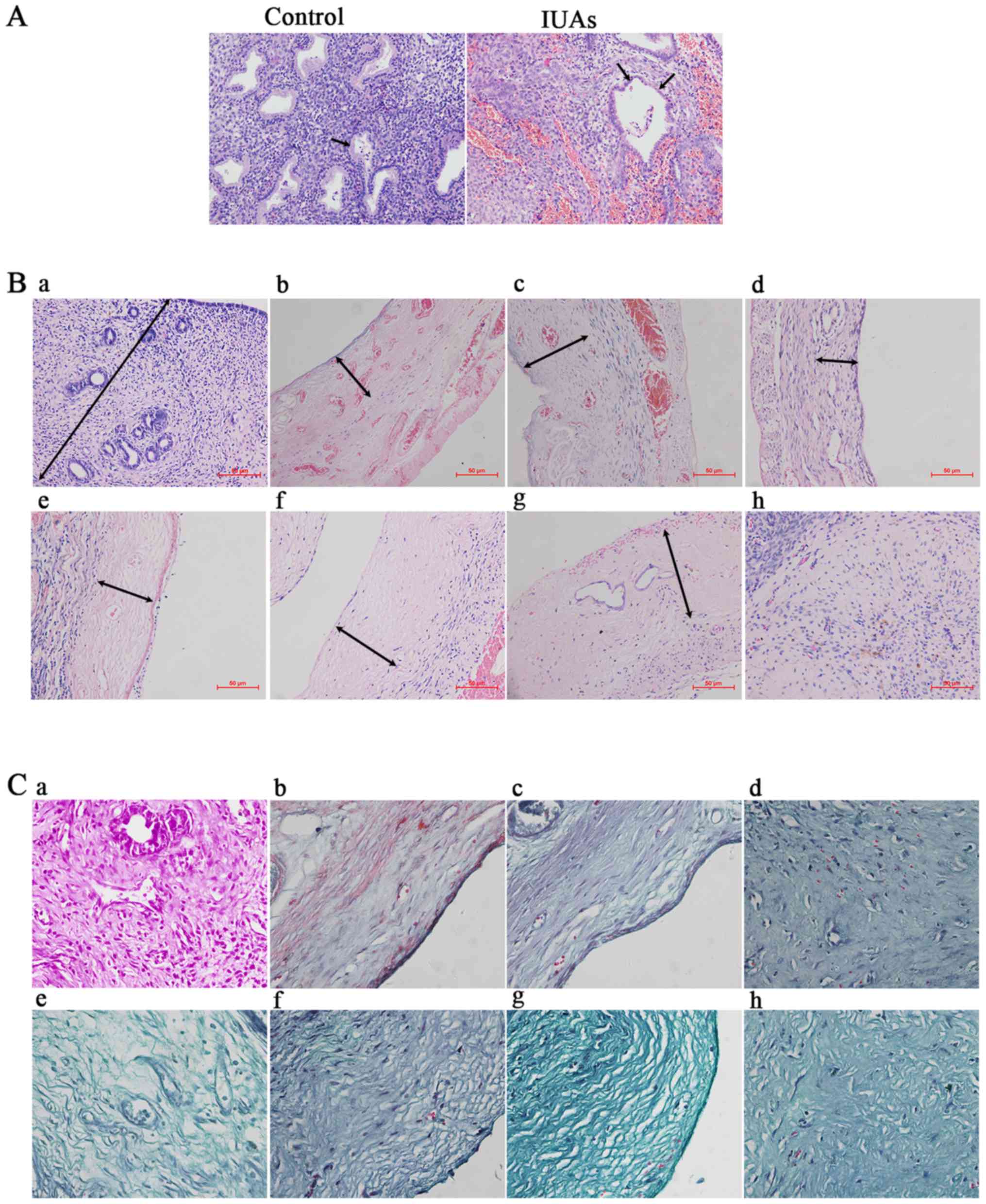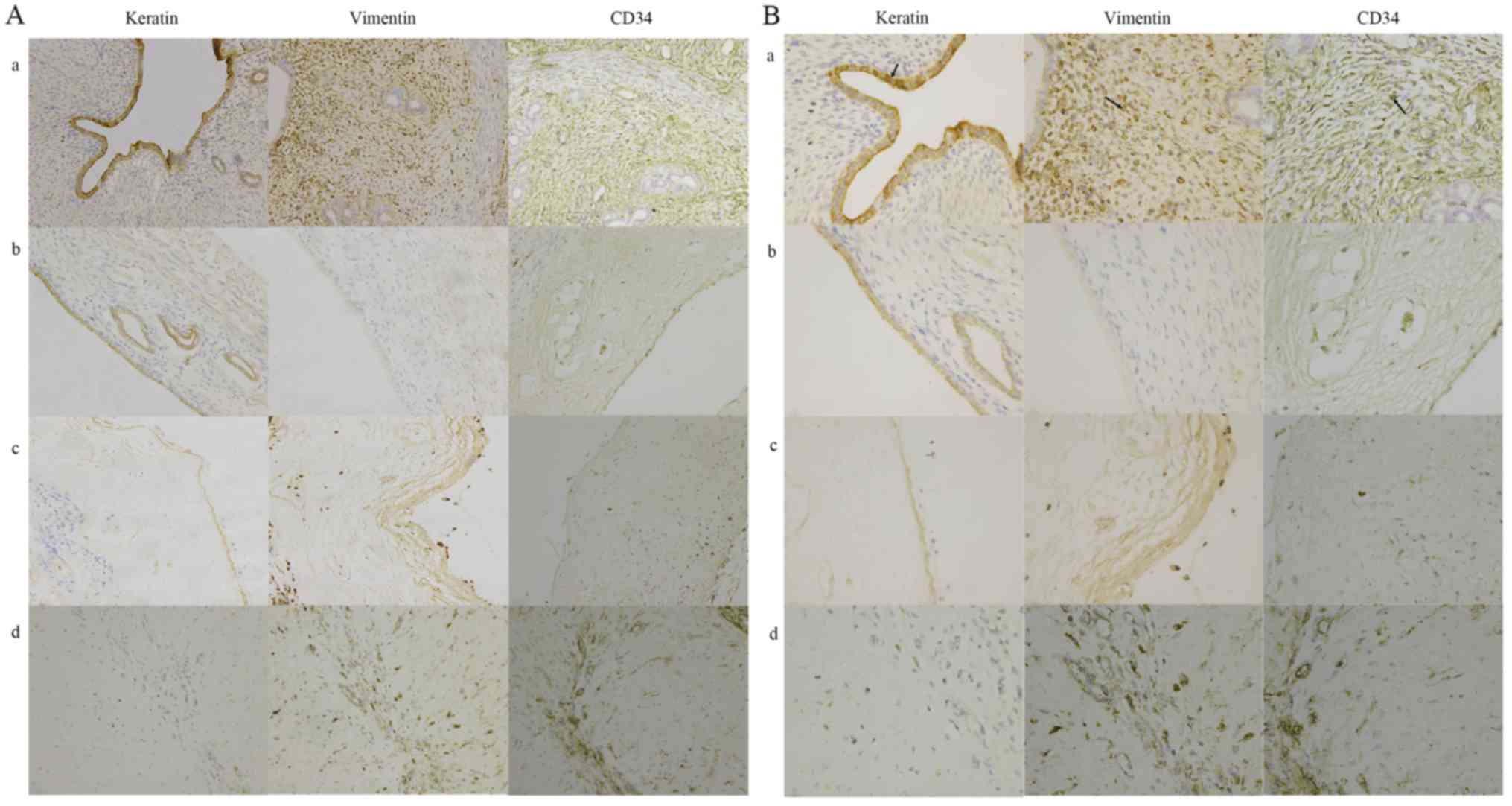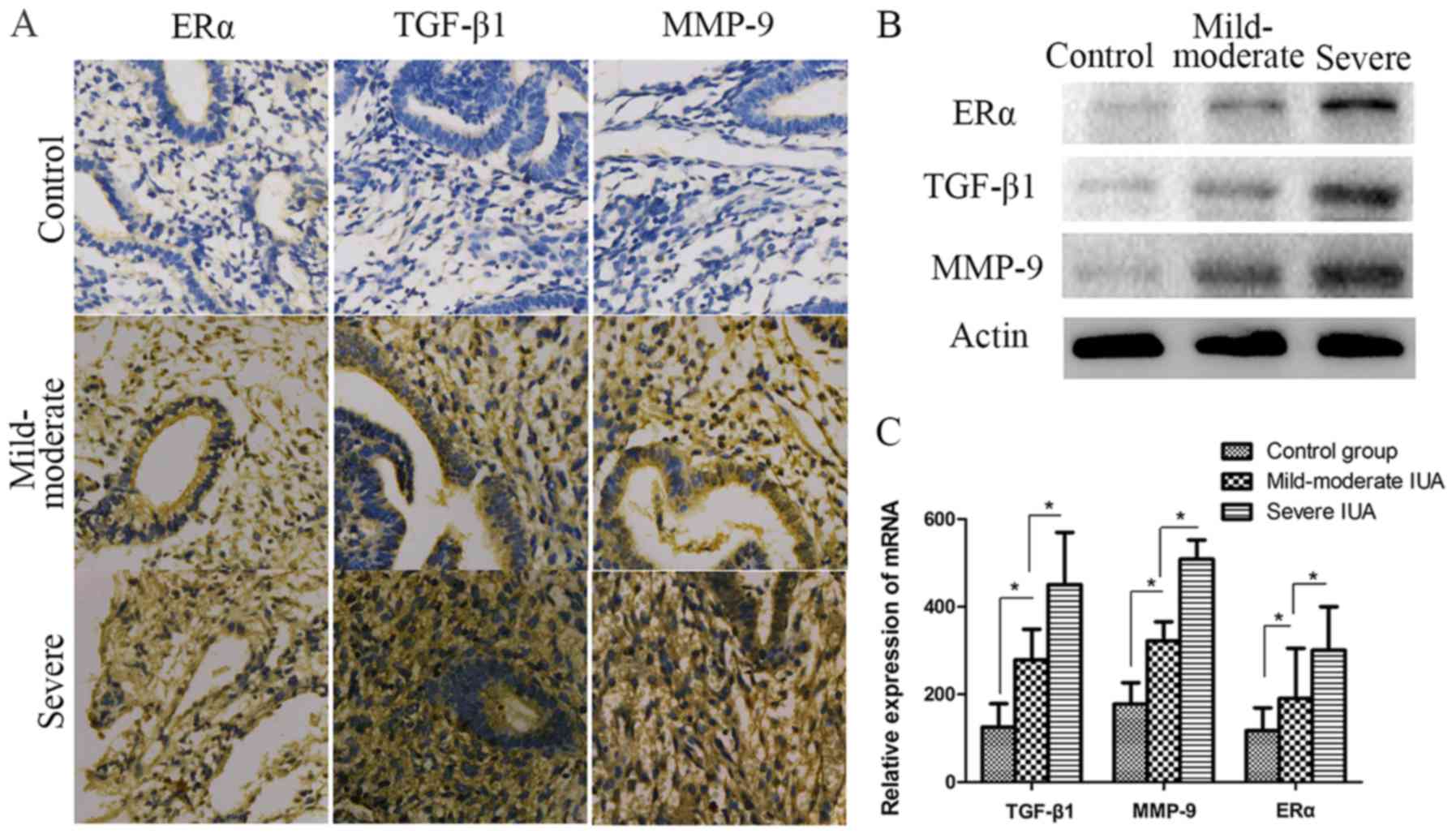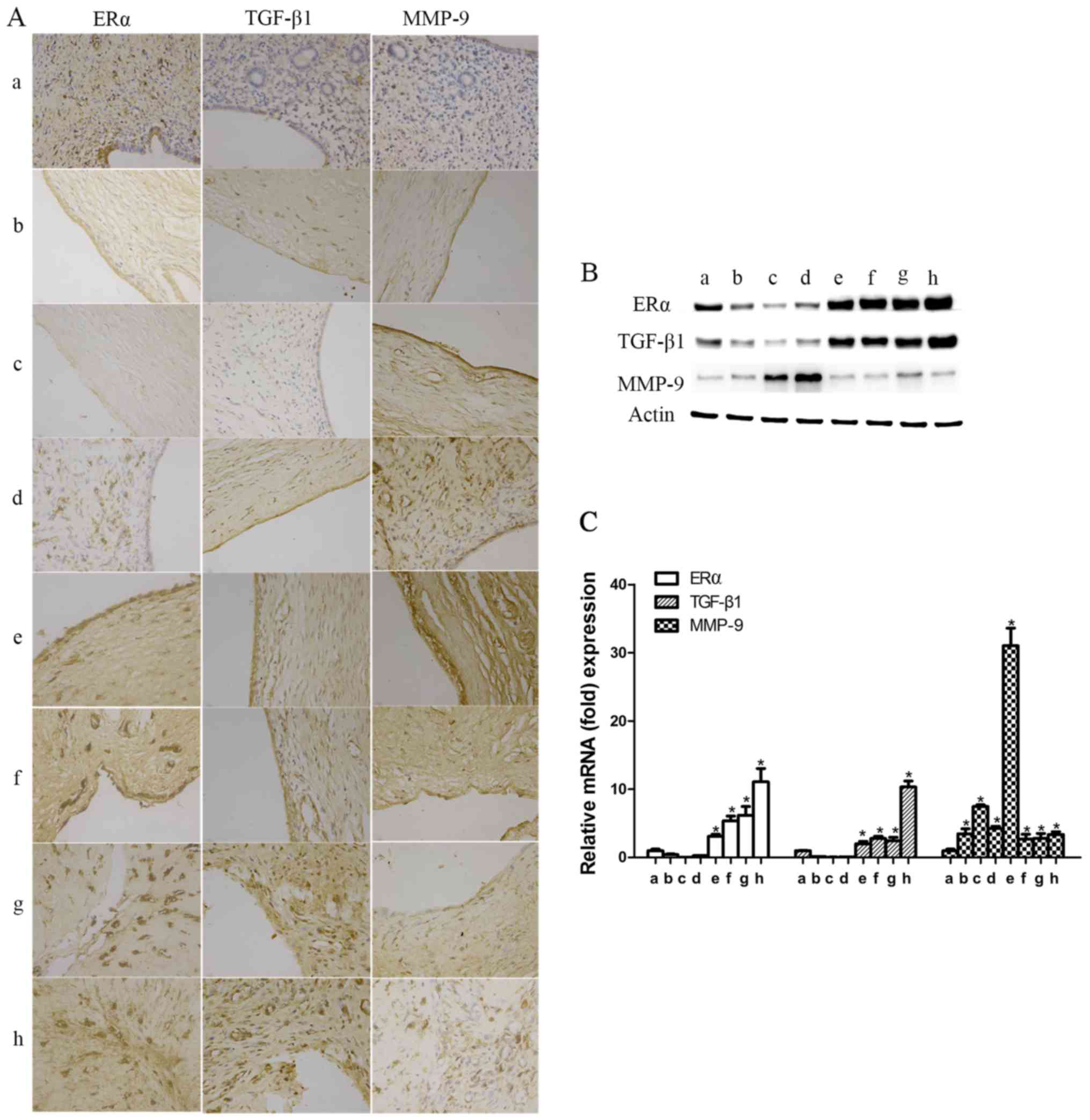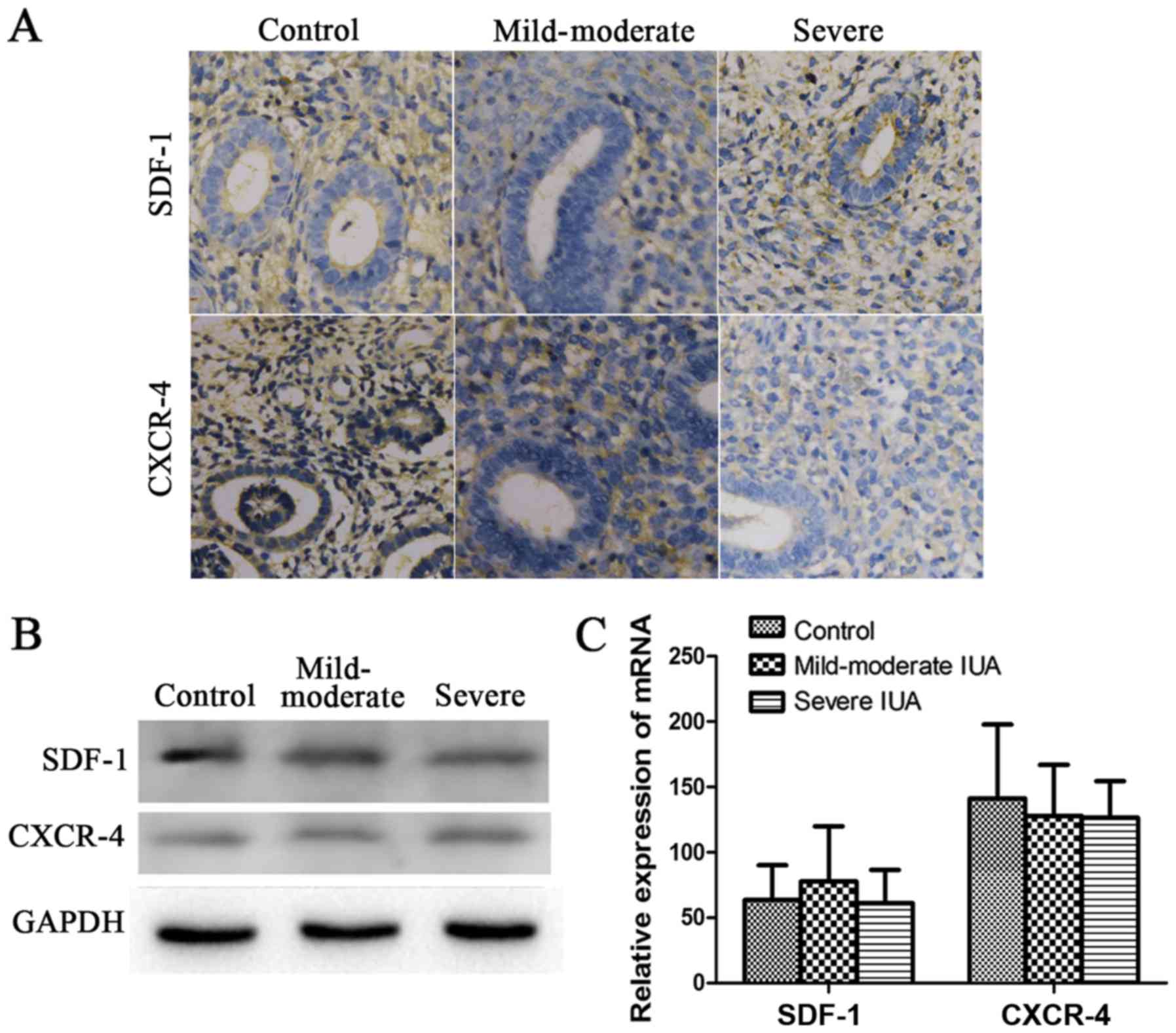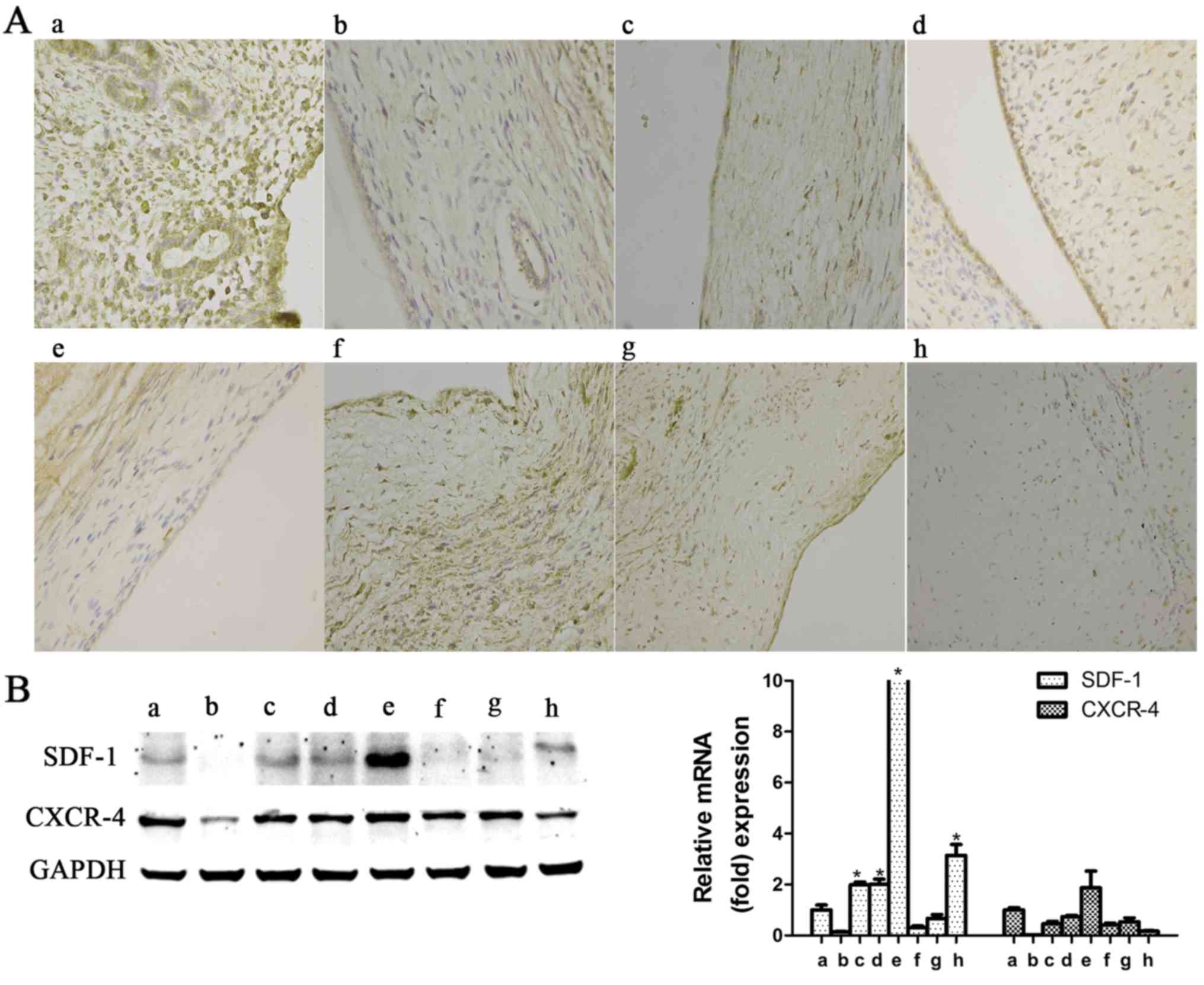|
1
|
Yu D, Wong YM, Cheong Y, Xia E and Li TC:
Asherman syndrome-one century later. Fertil Steril. 89:759–779.
2008. View Article : Google Scholar : PubMed/NCBI
|
|
2
|
Park JO, Lee BH, Kang YM, Kim TH, Yoon JY,
Kim H, Kwon UH, Lee KI, Lee HM and Moon SH: Inflammatory cytokines
induce fibrosis and ossification of human ligamentum flavum cells.
J Spinal Disord Tech. 26:E6–E12. 2013. View Article : Google Scholar
|
|
3
|
Hu J, Zeng B, Jiang X, Hu L, Meng Y, Zhu Y
and Mao M: The expression of marker for endometrial stem cell and
fibrosis was increased in intrauterine adhesious. Int J Clin Exp
Pathol. 8:1525–1534. 2015.PubMed/NCBI
|
|
4
|
Salma U, Xue M, Ali Sheikh MS, Guan X, Xu
B, Zhang A, Huang L and Xu D: Role of transforming growth factor-β1
and smads signaling pathway in intrauterine adhesion. Mediators
Inflamm. 2016:41582872016. View Article : Google Scholar
|
|
5
|
Rahimi RA and Leof EB: TGF-beta signaling:
A tale of two responses. J Cell Biochem. 102:593–608. 2007.
View Article : Google Scholar : PubMed/NCBI
|
|
6
|
Islam SS, Mokhtari RB, El Hout Y, Azadi
MA, Alauddin M, Yeger H and Farhat WA: TGF-β1 induces EMT
reprogramming of porcine bladder urothelial cells into collagen
producing fibroblasts-like cells in a Smad2/Smad3-dependent manner.
Cell Commun Signal. 8:39–58. 2014. View Article : Google Scholar
|
|
7
|
Zhao H, Dong Y, Tian X, Tan TK, Liu Z,
Zhao Y, Zhang Y, Harris D and Zheng G: Matrix metalloproteinases
contribute to kidney fibrosis in chronic kidney diseases. World J
Nephrol. 2:84–89. 2013. View Article : Google Scholar : PubMed/NCBI
|
|
8
|
Kramann R, Dirocco DP, Maarouf OH and
Humphreys BD: Matrix producing cells in chronic kidney disease:
Origin, regulation, and activation. Curr Pathobiol Rep. 1:2013.
View Article : Google Scholar : PubMed/NCBI
|
|
9
|
Maruyama T, Masuda H, Ono M, Kajitani T
and Yoshimura Y: Human uterine stem/progenitor cells: Their
possible role in uterine physiology and pathology. Reproduction.
140:11–22. 2010. View Article : Google Scholar : PubMed/NCBI
|
|
10
|
Kato K, Yoshimoto M, Kato K, Adachi S,
Yamayoshi A, Arima T, Asanoma K, Kyo S, Nakahata T and Wake N:
Characterization of side-population cells in human normal
endometrium. Hum Reprod. 22:1214–1223. 2007. View Article : Google Scholar : PubMed/NCBI
|
|
11
|
Gargett CE and Ye L: Endometrial
reconstruction from stem cells. Fertil Steril. 98:11–20. 2012.
View Article : Google Scholar : PubMed/NCBI
|
|
12
|
Jing Z, Qiong Z, Yonggang W and Yanping L:
Rat bone marrow mesenchymal stem cells improve regeneration of thin
endometrium in rat. Fertil Steril. 101:587–594. 2014. View Article : Google Scholar
|
|
13
|
Zhao J, Zhang Q, Wang Y and Li Y: Uterine
infusion with bone marrow mesenchymal stem cells improves
endometrium thickness in a rat model of thin endometrium. Reprod
Sci. 22:181–188. 2015. View Article : Google Scholar :
|
|
14
|
Wang L, Guo S, Zhang N, Tao Y, Zhang H, Qi
T, Liang F and Huang Z: The role of SDF-1/CXCR4 in the
vasculogenesis and remodeling of cerebral arteriovenous
malformation. Ther Clin Risk Manag. 11:1337–1344. 2015.PubMed/NCBI
|
|
15
|
Yang D, Sun S, Wang Z, Zhu P, Yang Z and
Zhang B: Stromal cell-derived factor-1 receptor
CXCR4-overexpressing bone marrow mesenchymal stem cells accelerate
wound healing by migrating into skin injury areas. Cell Reprogram.
15:206–215. 2013.PubMed/NCBI
|
|
16
|
Tica AA, Tica OS, Georgescu CV, Pirici D,
Bogdan M, Ciurea T, Mogoanta SS, Georgescu CC, Comanescu AC,
Balseanu TA, et al: GPER and ERα expression in abnormal endometrial
proliferations. Rom J Morphol Embryol. 57:413–418. 2016.
|
|
17
|
Hu H and Yuan R: Estrogen receptor ESR1
promotes BMSCs cell proliferation and migration via regulation of
SDF-1/CXCR4 signaling. Int J Clin Exp Med. 9:21092–21099. 2016.
|
|
18
|
The American Fertility Society
classifications of adnexal adhesions, distal tubal occlusion, tubal
occlusion secondary to tubal ligation, tubal pregnancies, mullerian
anomalies and intrauterine adhesions. Fertil Steril. 49:944–955.
1988. View Article : Google Scholar
|
|
19
|
Zhao J, Gao H and Li Y: Development of an
animal model for thin endometrium using 95% ethanol. J Fert In
Vitro. 2:42012.
|
|
20
|
Hunter RK II, Nevitt CD, Gaskins JT,
Keller BB, Bohler HC Jr and LeBlanc AJ: Adipose-derived stromal
vascular fraction cell effects on a rodent model of thin
endometrium. PLoS One. 10:e01448232015. View Article : Google Scholar : PubMed/NCBI
|
|
21
|
Harvey BK, Airavaara M, Hinzman J, Wires
EM, Chiocco MJ, Howard DB, Shen H, Gerhardt G, Hoffer BJ and Wang
Y: Targeted overexpression of glutamate transporter 1 (GLT-1)
reduces ischemic brain injury in a rat model of stroke. PLoS One.
6:e221352011. View Article : Google Scholar
|
|
22
|
Chen Y, Chang Y and Yao S: Role of
angiogenesis in endometrial repair of patients with severe
intrauterine adhesion. Int J Clin Exp Pathol. 6:1343–1350.
2013.PubMed/NCBI
|
|
23
|
Sui X, Wei H and Wang D: Novel mechanism
of cardiac protection by valsartan: Synergetic roles of TGF-β1 and
HIF-1α in Ang II-mediated fibrosis after myocardial infarction. J
Cell Mol Med. 19:1773–1782. 2015. View Article : Google Scholar : PubMed/NCBI
|
|
24
|
Harris WT, Kelly DR, Zhou Y, Wang D,
MacEwen M, Hagood JS, Clancy JP, Ambalavanan N and Sorscher EJ:
Myofibroblast differentiation and enhanced TGF-B signaling in
cystic fibrosis lung disease. PLoS One. 8:e701962013. View Article : Google Scholar : PubMed/NCBI
|
|
25
|
Tao Z and Duan H: Expression of
adhesion-related cytokines in the uterine fluid after transcervical
resection of adhesion. Zhonghua Fu Chan Ke Za Zhi. 47:734–737.
2012.
|
|
26
|
Hu S, Li Y, Meng WJ and Tan SQ: Effects of
Fukang oral liquid on the prevention of intrauterine adhesion and
expressions of TGF-beta1, PAI-1 and MMP-9 in endometrium of rats.
Sichuan Da Xue Xue Bao Yi Xue Ban. 44:540–544. 2013.PubMed/NCBI
|
|
27
|
Musial K and Zwolinska D: Matrix
metalloproteinases (MMP-2,9) and their tissue inhibitors (TIMP-1,2)
as novel markers of stress response and atherogenesis in children
with chronic kidney disease (CKD) on conservative treatment. Cell
Stress Chaperones. 16:97–103. 2011. View Article : Google Scholar :
|
|
28
|
Zeisberg M, Khurana M, Rao VH, Cosgrove D,
Rougier JP, Werner MC, Shield CF III, Werb Z and Kalluri R:
Stage-specific action of matrix metalloproteinases influences
progressive hereditary kidney disease. PLoS Med. 3:e1002006.
View Article : Google Scholar : PubMed/NCBI
|
|
29
|
Catania JM, Chen G and Parrish AR: Role of
matrix metal-loproteinases in renal pathophysiologies. Am J Physiol
Renal Physiol. 292:F905–F911. 2007. View Article : Google Scholar
|
|
30
|
Lindberg MK, Weihua Z, Andersson N,
Moverare S, Gao H, Vidal O, Erlandsson M, Windahl S, Andersson G,
Lubahn DB, et al: Estrogen receptor specificity for the effects of
estrogen in ovariectomized mice. J Endocrinol. 174:167–178. 2002.
View Article : Google Scholar : PubMed/NCBI
|
|
31
|
Shen MS, Wang CW, Chen CH and Tzeng CR:
New horizon on successful management for a woman with repeated
implantation failure due to unresponsive thin endometrium: Use of
extended estrogen supplementation. J Obstet Gynaecol Res.
39:1092–1094. 2013. View Article : Google Scholar : PubMed/NCBI
|
|
32
|
Cai H, Li H and He Y: Interceed and
estrogen reduce uterine adhesions and fibrosis and improve
endometrial receptivity in a rabbit model of intrauterine
adhesions. Reprod Sci. 23:1208–1216. 2016. View Article : Google Scholar : PubMed/NCBI
|
|
33
|
Kim D, Lee AS, Jung YJ, Yang KH, Lee S,
Park SK, Kim W and Kang KP: Tamoxifen ameliorates renal
tubulointerstitial fibrosis by modulation of estrogen receptor
α-mediated transforming growth factor-β1/Smad signaling pathway.
Nephrol Dial Transplant. 29:2043–2053. 2014. View Article : Google Scholar : PubMed/NCBI
|
|
34
|
Mahmoodzadeh S, Eder S, Nordmeyer J, Ehler
E, Huber O, Martus P, Weiske J, Pregla R, Hetzer R and
Regitz-Zagrosek V: Estrogen receptor alpha upregulation and
redistribution in human heart failure. FASEB J. 20:926–934. 2006.
View Article : Google Scholar : PubMed/NCBI
|
|
35
|
Alawadhi F, Du H, Cakmak H and Taylor HS:
Bone Marrow-Derived Stem Cell (BMDSC) transplantation improves
fertility in a murine model of Asherman's syndrome. PLoS One.
9:e966622014. View Article : Google Scholar : PubMed/NCBI
|
|
36
|
Wang X, Gao Y, Shi H, Liu N, Zhang W and
Li H: Influence of the intensity and loading time of direct current
electric field on the directional migration of rat bone marrow
mesenchymal stem cells. Front Med. 10:286–296. 2016. View Article : Google Scholar : PubMed/NCBI
|















